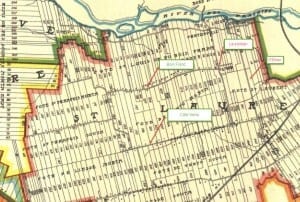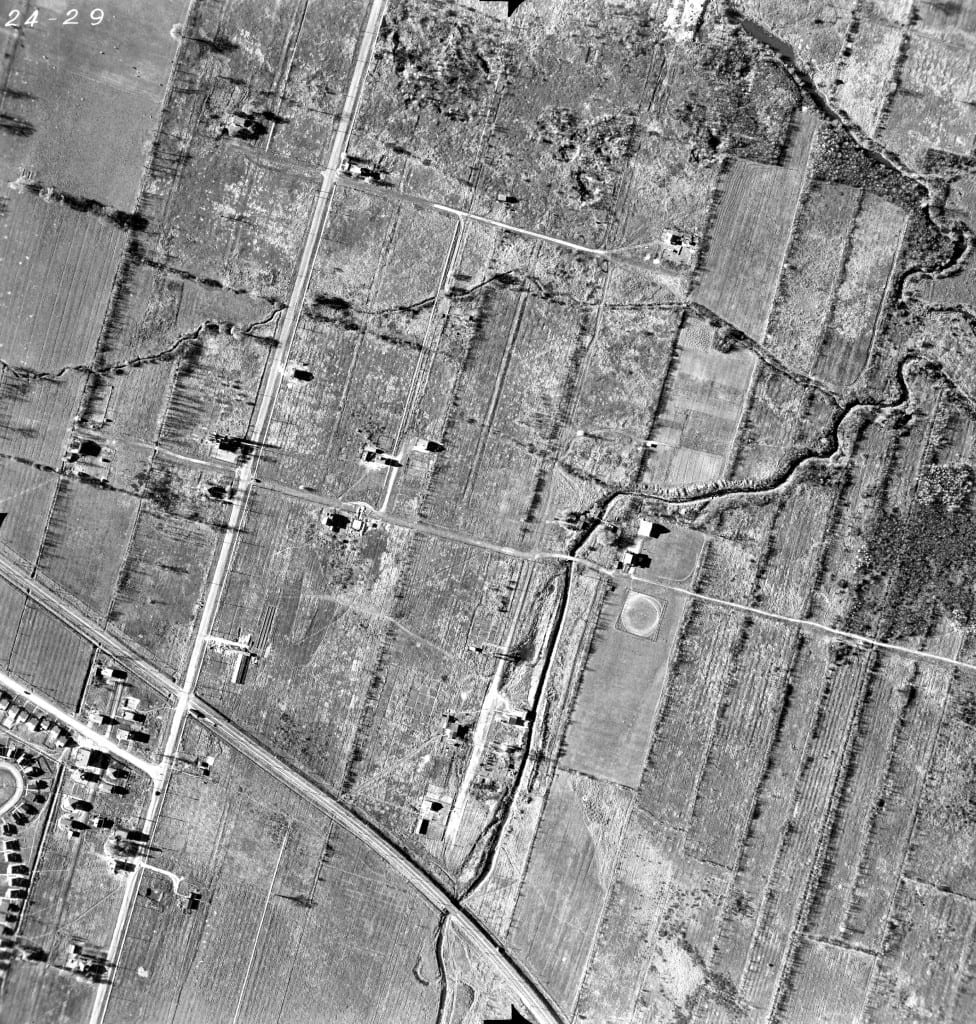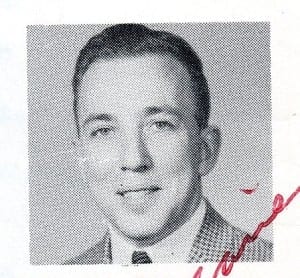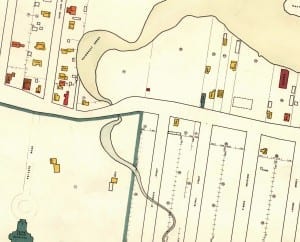Graeme Decarie (teacher at Malcolm Campbell High School) recalls Raimbault Creek, the stream that ran through Cartierville in the 1960s

1907 map, which includes an image of Raimbault Creek as it existed at the time. The early map, Tim Hewlings (MCHS ’63) notes, is from: A. R. Pinsoneault, Atlas of the Island and city of Montreal and Ile Bizard, s. l., The Atlas Publishing Co., vers 1907 found on the BANQ website.
We are pleased to let you know that Graeme Decarie has posted the following comment at a post entitled:
The stream that used to run through Cartierville in Montreal was called Raimbault Creek
I’ve posted this great message and have also posted the following comment in turn:
Message from Graeme Decarie
I remember the creek very well from the years before MCHS was built. When I was a Boy Scout, I spend many a weekend walking down the country road that is now the Laurentian Autoroute, usually with my .22 rifle to shoot a tin cans and other threats.
(I’m not actually an MCHS grad, just a teacher. I left in 1963 to go back to school.)
graeme decarie
[End of message]
Comment in response to message from Graeme Decarie
Wonderful to read your message, Graeme.
.22 rifles were a popular item in those days; I didn’t realize they were used along the country road that is now the Laurentian Autoroute. That’s a great detail to know about.
The MCHS Sixties Reunion welcomes teachers at its reunion on Oct. 17, 2015. We welcome your participation and the participation of other teachers who taught at MCHS in the 1960s, or who taught students who attended in the 1960s but who graduated in the 1970s.
The MCHS Sixties Reunion is for all students who attended in the 1960s, at any point, including those who started in the 1960s and graduated in the 1970s. Teachers who taught any of these students are most welcome at out reunion.
Anything that you can do, Graeme, in spreading the word among former MCHS teachers and administrators, who worked with the 1960s cohort, would be much appreciated.
As well, we welcome photos (from prewar times to the present day) from teachers and administrators, that we could post at this website and display as foamcore reproductions at Old Mill Toronto in October 2015 as part of the reunion.
As well, we would much enjoy posting an essay or report or reports from you or other teachers about any topic of interest to the MCHS Sixties students.
[End of message]
Aerial photo showing Raimbault Creek
The following photo is from a post entitled:

This is an archival document that Peter Halliday has forwarded to us. Click on the image for a closer view. Click again to enlarge the image further. The identifying data includes this file number: VM97-3_7P24-29.
Update
With regard to Montreal history, I’d like to bring your attention to Steven High’s website at Concord University. I became interested in his work when I began reading about the history of postwar deindustrialization in North America.




Oh my goodness. I remember you. When you went back to school what did you take? Did you stay in the teaching profession? You must have been about 22 years old when you started teaching – not much older than your students. I started teaching grade 2 in Dollard Des Ormeaux just before my 19th birthday in 1967 and retired in 2008 as a high school English teacher in Calgary.
Graeme Decarie has shared the following comment, for Marge Huk (Fuller):
Graeme Decarie writes:
Well, I was born in 1933. – and a started teaching in 1957 at Parkdale. (I flunked out of high school, but got into evening classes at Sir George as a mature student – then to teacher’s college, taught at parkdale while finishing a very bad BA at Sir George, and moved up to MCHS. Nobody would look at me for an MA with those grades. So, on the first day of school for 1963-64 , I made a wild decision. I quit, drove down to Acadia U., and begged for a chance to do an MA. They reluctantly allowed me to do another undergrad year as a test. So I did, got my act together and got straight As, did another year for the MA, and got a scholarship to Queen’s for the PhD.
Taught at UPEI for three years, then got an offer from Loyola (now part of concordia U). Back in Montreal, I also lucked into a spot on CBC radio for a dozen years. But they dropped me when I became too prominent in the language wars. (I was chairman of Alliance Quebec). Then I got a call from Gord Sinclair at CJAD to do a daily show – and it was close to my Con U office. So I did that for a dozen years. I also did quite a bit of TV for CBC, CTV, global, BBC, NBC… And wrote for newspapers and magazines. Also taught History in The Netherlands and China – and journalism to working reporters in China.
I loved every minute of teaching – and I miss it terribly.
[End of text from Graeme Decarie]
Hi Graeme, I was in Miss Kiddy or was it kettty’s class at Parkdale when you were a student teacher. I remember standing beside you MG TC ( I believe ) talking about it with you. I was in Mr. Allen’s 10B the first year at MCHS. I was the one who turned Mr. Allen’s Renault sideways between two other teachers cars in the parking lot beside the autoroute.. I remember you interviewed me for the high school radio rep. ( I forgot the station ). When I got the position Talbot ( who hated me ) pulled MCHS from the program.
That might have been Miss Keddy (though I can’t remember what she looked like). Wasn’t she an older teacher? Yeah, I think it’s started to come back to me. And I remember that I did do a week of practice teaching at parkdale.
Raimbault creek was clean then.But when Canadair dumped in it it was a sewer. Finally covered over for the park behind immaculata school.
I enjoyed the reference (Marge Huk (Fuller)) to how young people could be when they began their teaching careers. I was interested to read about Graeme Decarie’s teaching career (see comment above). I retired from teaching in 2006. In my case, the career began around my late twenties. As a child, I would never have imagined that one day I’d be standing in front of a class, in the role of a teacher. It would never have occurred to me.
I enjoyed the creek, in the 1950s and 1960s, before it was gone. I’ve written about my own recollections of the stream at a blog post some time back:
Farmers’ fields north of Montreal is where the City of Laval was built
I remember one time a local resident told me and some other kids (this must have been around the late 1950s, when he told us the story) about the time, some decades earlier, when the water in Raimbault Creek was clean enough so that kids could enjoy their summers swimming in it.
There’s a creek near where we live now, in Toronto, that also used to be clean enough for kids to swim in. People have great memories of times spent there when they were kids in the prewar years:
Here’s a quick view of Marie Curtis Park, before and after the creek was channelized
The 1949 map provided by Tim Hewlings shows St Evariste Street & Notre Dame des …. Looks like the same area as present day Raimbault Park. Search Google Maps “Notre Dame des Anges, Montreal, Quebec”. You’ll see area: The creek is more like an inlet today; nearby streets include Gouin Bd, St Evariste & St. Germain.
We moved to Rosalie Street (Jean Masse) in 1954 and played in The Creek”. It became the highway for our rafts and as the creek shrivelled our craft had to get through the big corrugated pipes under the roads. Ron Chartier and I started at Elmgrove then Morison and then MCHS – yes it became a sewer but in the early years it was a playground.
For sure it was a journey from a creek into a creek banished underground becoming a sewer. I remember good times playing along the creek around the mid-1950s, sometimes going rafting with bloodsuckers swimming around our toes. In at least one winter, the creek froze over and we could skate a long ways along the creek. Then in the spring the ice would start to get thin and you had to take care you didn’t fall in.
One time I met someone who said that some decades earlier, the creek used to be unpolluted and kids would swim in it during the summers. Lots of kids jumping in having a good time. I’m guessing that would have been around the 1920s, 1930s. Occasionally I read about creeks that have been turned into sewers that eventually get ‘daylighted’ – brought back to life on the surface once again.
Where I live now in Stratford there’s evidence of where creeks used to run and where I guess they are running along sewers now. We used to live in South Etobicoke in Toronto and I was aware of the history of creeks and streams in neighbourhoods: that used to be there and now are gone.
Here’s a map that shows where I used to live, on Lavigne Street between Rue de Salaberry and Rue Forbes:
Rue Lavigne, Montréal, QC
Part of the creek used to run parallel to Rue Forbes, on its way to Riviera des Prairies. I see from the map that there’s a Park Raimbault (which may also appear in the 1949 map that Tim Hewlings has shared) north of Gouin. The autoroute is to the east of Parc Sainte-Odile, which used to be largely a wooded area – part of what was called “The Bush” – that the creek ran through. Where the autoroute is now located used to be part of The Bush.
Where Cartierville begins and ends – where the boundaries are – is a matter of interest, which I’ve explored in one of my earlier posts about Cartierville and the nearby communities.
We lived on St.Evariste just down from de Salaberry from about 1954 or 1955. My Dad would take me and a my friend Ronny down to the creek at the north end of the street. It seems to me we tried fishing the creek but we never caught anything. When I was about 11 or so we used to take our bicycles down the street, along the creek, all the way to Raimbault park where we would fish the Back River. On one occasion I caught an eel in the river. Nothing fights quite like an eel. Of course when you are 11 or 12 all eels are ‘electric eels’ and no one would dare touch the creature. To my relief the eel flipped off the hook and back into the river.
Most interesting to read your comment, Marty. I remember that there were some kind of fish called catfish in the creek, with long whiskers. There were also these leech-type creatures that took hold of the skin on your feet if you happened to try rafting on the creek. They held on tightly. I’m looking forward to finding aerial photos and also street maps showing the creek in the 1950s between the Back River and de Salaberry.
Hi All. Great comments from all.
We lived in Rue Elizabeth in the apartments way back in 1955 or so. Then we moved to Rue Fillion near St, Laurent Park which was all much less developed in those days! I went to two different primary schools which I think are the ones now called Des Grands Etres and Parkdale Elementary School (though Parkdale does ring a bell) but I can not remember what their names were at the time. I am judging this by navigating Google Street view.
I am wondering if the Raimbault Creek is the one that ran under the fence to the south east end of the Canadair plant at the end of the runway. It was possible to climb under the fence where the creek entered the airfield and there were a number of scrapped and burnt out aircraft frames which me and my friend (both of us only 8 years old!) used to play in.
Most memorable was the time when a Sabre Jet ran its engines up prior to take off. I don’t know how close we were but we were hiding in the scrap in case the pilot saw us and I vividly remember the resonance of my lungs vibrating quite violently to the noise!
Just to finish, we moved away in 1958.
This is amazing. You were my best friend back in the early 50s Dave. You lived next door to me at number 4, Elizabeth Street, I have good recollections of us crawling through the drain pipe under Laurentian Blvd and into the grounds of Canadair and playing in the scrapped planes. I say amazing because by coincidence I am in the process of writing a book and this incident features. The other amazing coincidence is that I too returned to England in 1960 but by that time you and I had lost touch. Gotta get in touch Davey. suttonp@ntlworld.com or find me on Facebook.
I guess one could find an online aerial map, something like the map at the post we are now looking at, to find out whether Raimbault Creek ran as far as the Canadair plant. I recall from skating on the creek one winter, when the creek froze and when at the same time there was not much snow, that you could skate a very, very long way south along the creek.
It was so interesting to see the local environment (which had not yet been touched by extensive residential development) from that vantage point: children skating together along the creek, marvelling at the sights. Thus, it’s an interesting question: Did the creek go as far as Canadair? We lived on Lavigne Street between de Salaberry and Forbes. The creek ran along Forbes; that’s where in my case we would start the skating from.
We’ve spoken at this website about the eventual disappearance of the creek; one post that refers to this topic, by way of example, is entitled:
Farmers’ fields north of Montreal is where the City of Laval was built
I remember riding on a bike, with a francophone friend named Claude, to spend time at the edge of the Canadair plant to watch the Sabre jets taking off. I had pretty much forgotten about those visits to see the jets, until I read the comment from Dave Bush just now.
I had a used bike. It cost $25. Eventually the ball bearings on the front wheel fell out and that was the end of the bike. The bike was purchased at a great bike shop:
Chez ‘Hade’ was a wonderful bike shop on Lower Ranger St. & Gouin in 1950s Cartierville
Tim Hewlings and Bert Eccles continue discussion about Chez ‘Hade’ in Cartierville; as well Don MacKenzie adds to comments about Morison School
Many decades later I bought a new bike, which I’ve much enjoyed riding over the years. With regard to bikes, I was impressed (especially once I learned about the city’s civic history in opposition to ‘car culture,’ starting in the 1970s) with the ‘bicycle culture’ that I witnessed on a family visit to Amsterdam in 2018:
Bicycle culture in Amsterdam is impressive
Hi Jaan.
After thinking about it, I don’t think the stream under the airfield fence could have been the Raimbault Creek. It was far too small to allow swimming or ice skating as described here.
Thanks for the references. There is a lot of very interesting information to me about Cartierville.
I have come to the conclusion that the school Des Grands-Etres was Elmgrove and what is now Parkdale was the elementary part of Malcom Campbell School. It would be brilliant if someone could confirm that or put me right.
Has Parkdale (Malcom Campbell) been rebuilt since the 50’s? I remember a different layout and with wooden classrooms outside the main building (Temporary?). There were large French windows to the classroom that could be opened on a hot day. We moved back to England in 1960 and one of the things I missed in my school were these large opening doors to the field outside.
I remember one of those major steps at the school with a bit of pain (lol!). I was the last person in the class allowed to progress to writing with ink because of my poor handwriting! And I remember using basic pen nibs and inkwells and getting ink all over my hands. I was good at maths however.
Cheers, Dave
Hi Dave
Could you possibly be the same Dave Bush that live on Elizabeth St, VSL early to mid 50s? If so you and I were best friends for a while and went to cubs together at Parkdale before you moved to Dorval. If I remember right, you had a sister Susan and your father was Peter. If you are that same Dave Bush I’d love to hear from you. Got a lot to tell you. Cheers.
Here’s what Bob Carswell has written at one of the discussions about Elmgrove; the comment is at a post entitled:
Grade 7 photos from Elmgrove School – with thanks to MCHS grad Susan Holmes Nash
Elmgrove School like a lot of other English Schools in the Montreal area seems to see its last days around the same time that MCHS closed down in 1987. The school building still exists to this day but for many years now has been a French school, and its latest venture is a relatively new one. It is known as “Primary School Des Grands-Êtres.”
You can find photographs of it on Google Maps at 1150 Rue Deguire. Built as an elementary school under the Protestant School Board in 1954 to accommodate the baby-boom after WWII, the push to a large French community in Quebec in the 60s and 70s started the departure of more than a hundred thousand English people from the province who followed their corporate jobs or needed employment after finishing university in a city that was almost vacant downtown throughout the 1980s.
I spent a week per month in the city so I can tell you personally, that St. Catherine Street was totally vacant at one point. The former Elmgrove School building was acquired by the Marguerite-Bourgeoys school board in 2014 to meet specific needs in the city. What it was used for between 1987 and 2014, I cannot tell you. In order to meet the needs of the school, the building has since been expanded as photos on Google Maps will show you.
‘Grand-Êtres Primary School’ is an institution that brings together around 575 pre-school and primary school students each year. It should be noted that the students of the school do not live nearby, which means that the vast majority of students are transported by bus. The school’s clientele is mainly multi-ethnic and predominantly disadvantaged (index of 9 on a possible 10).
A great many Lebanese and Syrian refugees make up the families using the services of the school. The parents of the students are mainly allophone with only about 10% using French as their language spoken at home, but this does not prevent the promotion of education. The education of their children is sometimes the main reason which explains their immigration.
A recent parent survey showed that for 97% of parents, the relationship they have maintained with teachers is good. As far as students are concerned, 97% of students like to come to school. In addition, all of the graduate students believed that school gave them a chance to improve and succeed.
Regarding the above-noted comment, I’ve added the following text at the same blog post as Bob Carswell’s comment:
Good to read the overview, Bob. It’s good to have the additional information. Would I be correct assuming the details are from Wikipedia?
[Bob replied: “No, I went to the trouble of reading the French on the actual website for the school translating some of it and making up the story. If you want to add photos of the present school. you can copy them from Google maps.”]
The topic of changes in Montreal since the days we attended MCHS is for much interest; it’s a topic explored at previous posts including:
Many changes have occurred in Cartierville where Malcolm Campbell High School was located from 1960s to late 1980s
Graeme Decarie has a question about the old Bois Franc. Do you know the answer?
Recent comments at Preserved Stories website bring to mind memories of Canadian musician Marty Butler, and of Marlborough Golf Club